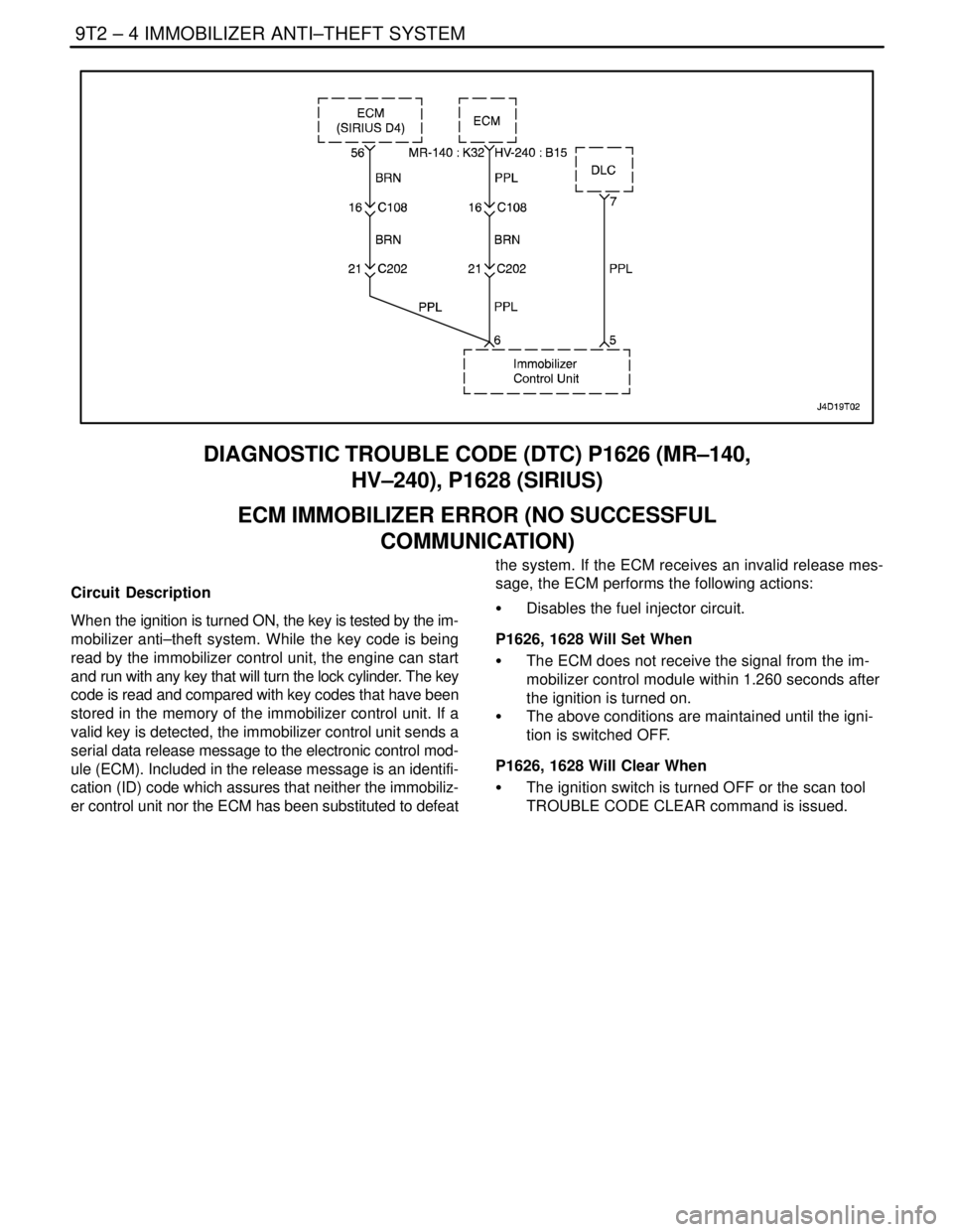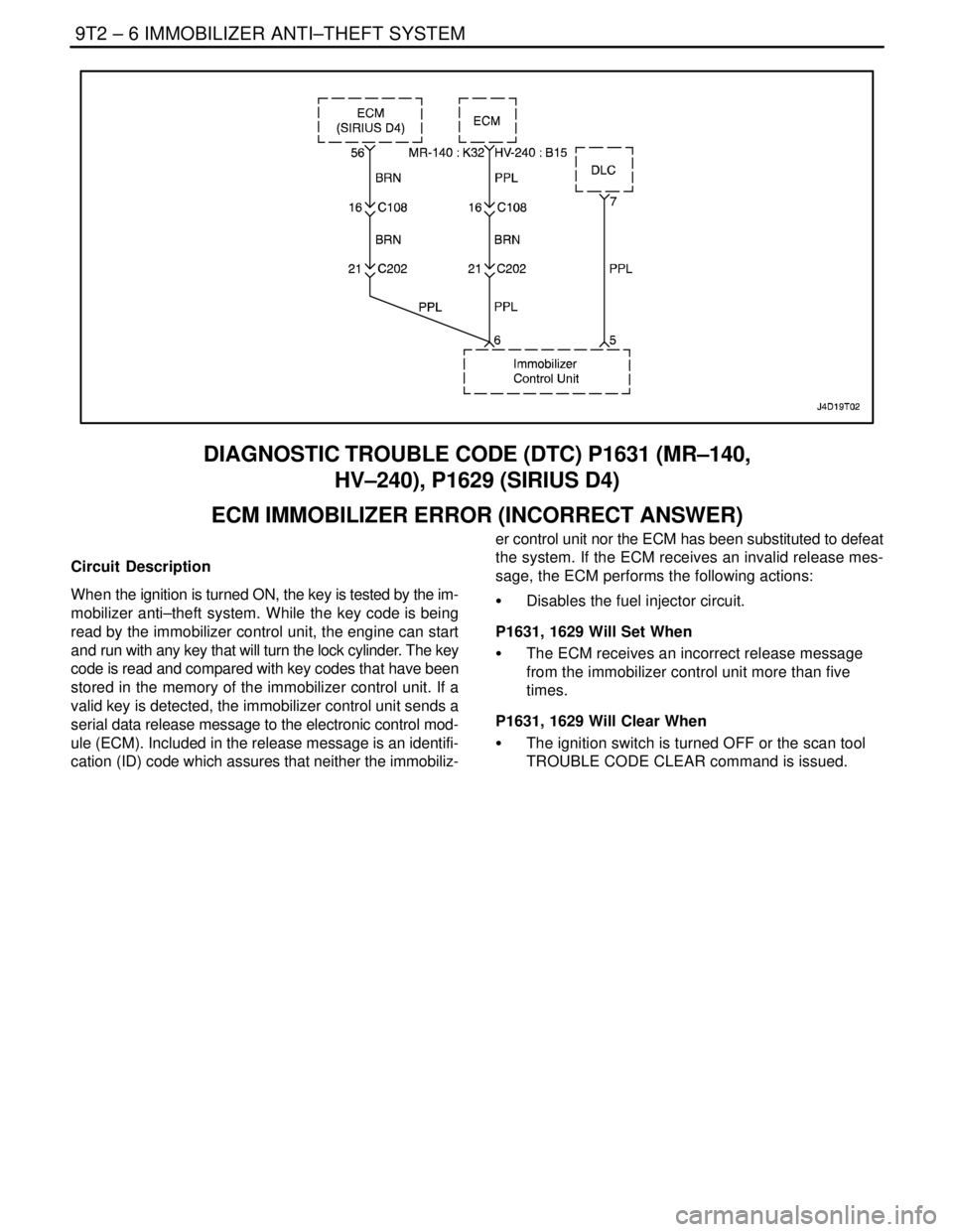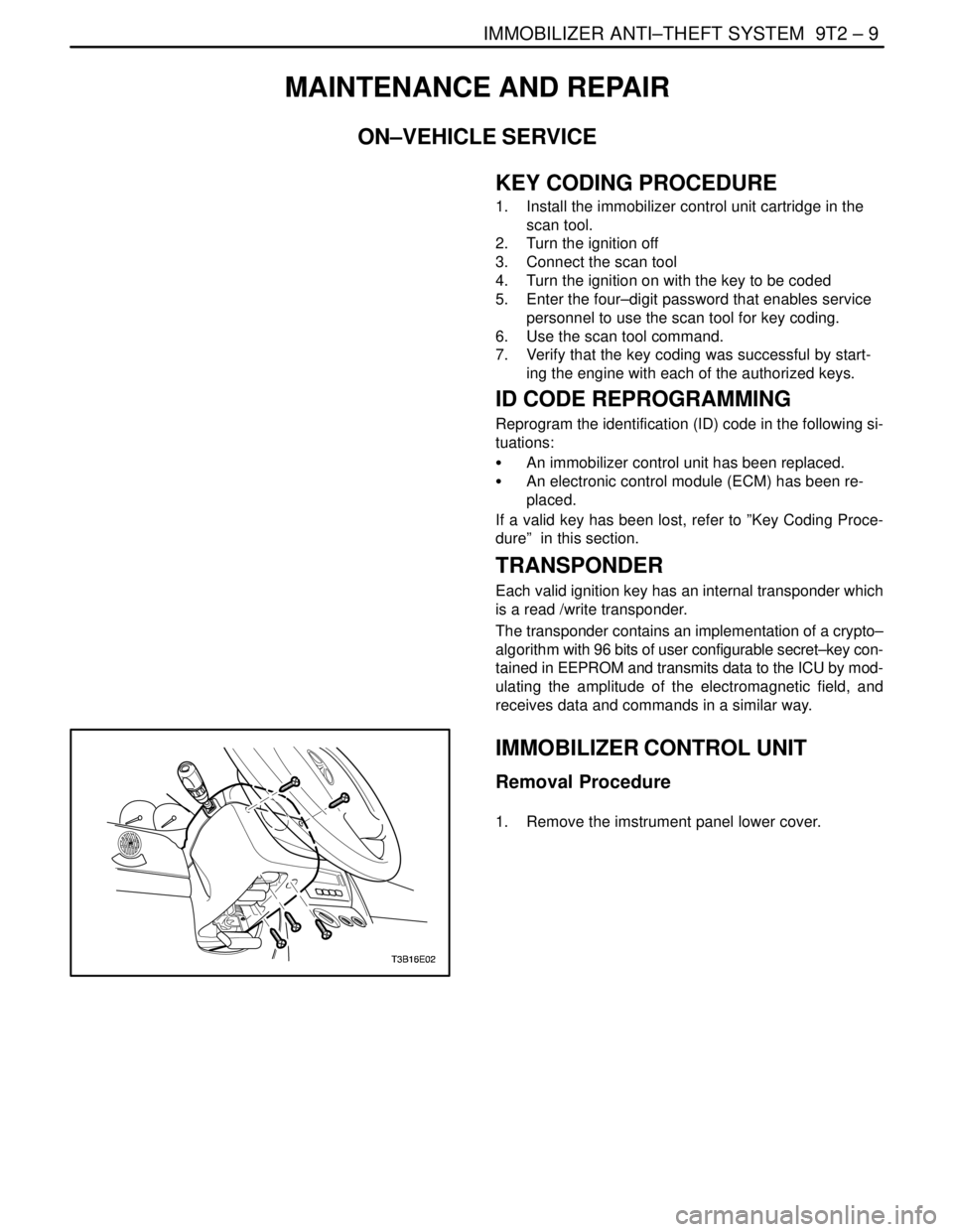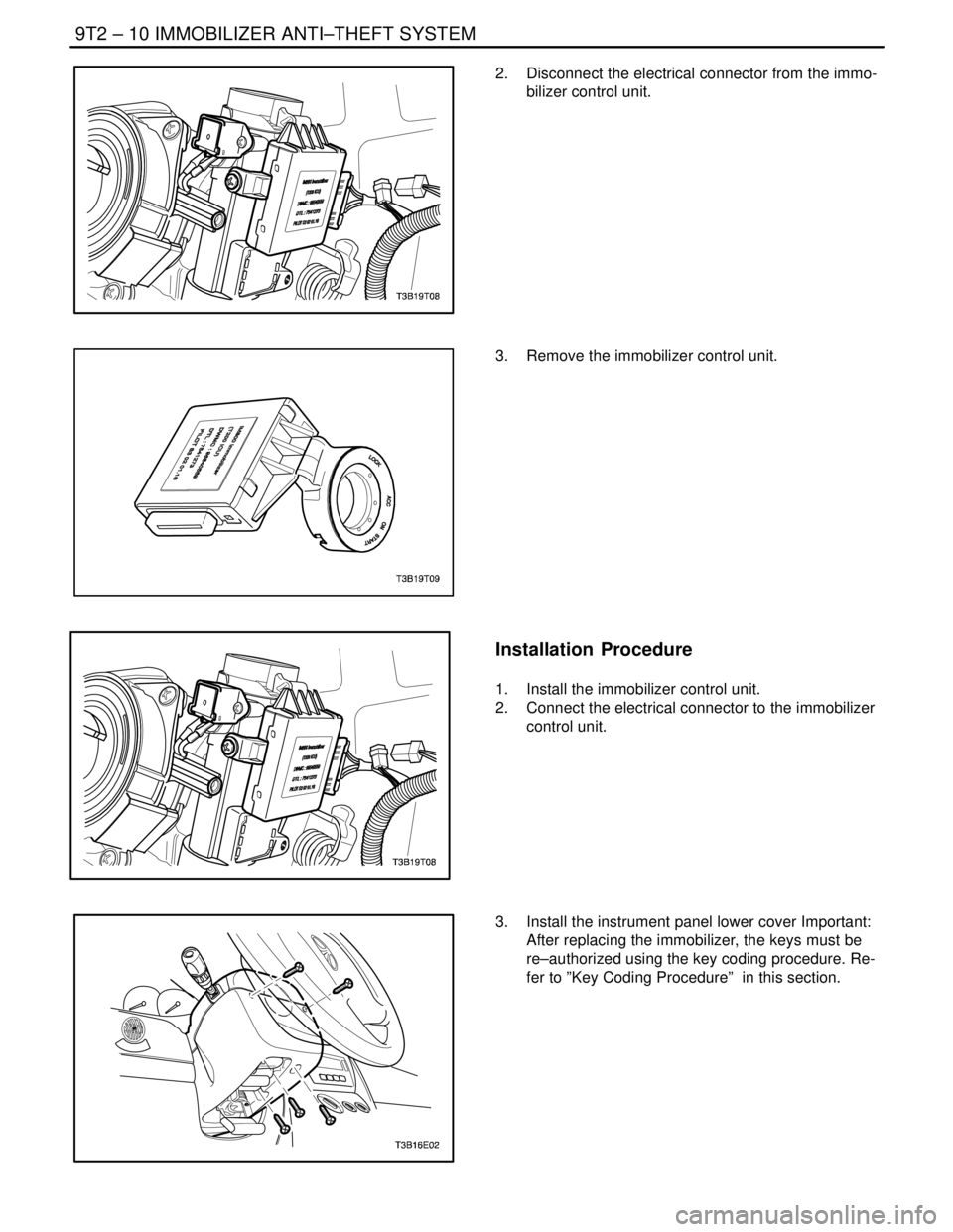2004 DAEWOO NUBIRA key
[x] Cancel search: keyPage 2493 of 2643

IMMOBILIZER ANTI–THEFT SYSTEM 9T2 – 3
DAEWOO V–121 BL4
DIAGNOSTIC INFORMATION AND
PROCEDURES
IMMOBILIZER SYSTEM (MR–140,
HV–240, SIRIUS D4)
The immobilizer anti–theft system requires diagnosis
when it is not possible to start the engine. If the no–start
condition occurs because of the immobilizer system, a
diagnostic trouble code (P) 1626, 1628, 1629, 1631 should
be set.
The immobilizer control unit monitors the detection and
the reading of the ignition key. The self–test capacity is lim-
ited to those functions. Faults are communicated to a scan
tool during diagnosis, but they are not stored in the immo-
bilizer control unit’s memory.Unauthorized use of a scan tool could be a method of de-
feating the immobilizer anti–theft system, so certain scan
tool procedures require the use of a password. The follow-
ing functions are password protected:
S Coding of an additional key.
S Deleting all key codes.
The following functions do not require a password:
S Reading an ignition key to determine if the trans-
ponder is working or if a key is authorized.
S Reading the immobilizer ID code to verify that it
matches the ECM ID code.
Page 2494 of 2643

9T2 – 4IIMMOBILIZER ANTI–THEFT SYSTEM
DAEWOO V–121 BL4
DIAGNOSTIC TROUBLE CODE (DTC) P1626 (MR–140,
HV–240), P1628 (SIRIUS)
ECM IMMOBILIZER ERROR (NO SUCCESSFUL
COMMUNICATION)
Circuit Description
When the ignition is turned ON, the key is tested by the im-
mobilizer anti–theft system. While the key code is being
read by the immobilizer control unit, the engine can start
and run with any key that will turn the lock cylinder. The key
code is read and compared with key codes that have been
stored in the memory of the immobilizer control unit. If a
valid key is detected, the immobilizer control unit sends a
serial data release message to the electronic control mod-
ule (ECM). Included in the release message is an identifi-
cation (ID) code which assures that neither the immobiliz-
er control unit nor the ECM has been substituted to defeatthe system. If the ECM receives an invalid release mes-
sage, the ECM performs the following actions:
S Disables the fuel injector circuit.
P1626, 1628 Will Set When
S The ECM does not receive the signal from the im-
mobilizer control module within 1.260 seconds after
the ignition is turned on.
S The above conditions are maintained until the igni-
tion is switched OFF.
P1626, 1628 Will Clear When
S The ignition switch is turned OFF or the scan tool
TROUBLE CODE CLEAR command is issued.
Page 2496 of 2643

9T2 – 6IIMMOBILIZER ANTI–THEFT SYSTEM
DAEWOO V–121 BL4
DIAGNOSTIC TROUBLE CODE (DTC) P1631 (MR–140,
HV–240), P1629 (SIRIUS D4)
ECM IMMOBILIZER ERROR (INCORRECT ANSWER)
Circuit Description
When the ignition is turned ON, the key is tested by the im-
mobilizer anti–theft system. While the key code is being
read by the immobilizer control unit, the engine can start
and run with any key that will turn the lock cylinder. The key
code is read and compared with key codes that have been
stored in the memory of the immobilizer control unit. If a
valid key is detected, the immobilizer control unit sends a
serial data release message to the electronic control mod-
ule (ECM). Included in the release message is an identifi-
cation (ID) code which assures that neither the immobiliz-er control unit nor the ECM has been substituted to defeat
the system. If the ECM receives an invalid release mes-
sage, the ECM performs the following actions:
S Disables the fuel injector circuit.
P1631, 1629 Will Set When
S The ECM receives an incorrect release message
from the immobilizer control unit more than five
times.
P1631, 1629 Will Clear When
S The ignition switch is turned OFF or the scan tool
TROUBLE CODE CLEAR command is issued.
Page 2498 of 2643

9T2 – 8IIMMOBILIZER ANTI–THEFT SYSTEM
DAEWOO V–121 BL4
KEY STATUS ERRORS (MR–140,
HV–240, SIRIUS D4)
The following KEY STATUS messages may be shown on
the scan tool after commanding FIRST KEY CODING and
KEY ADD:
S IGNITION OFF STATUS. This message informs
the technician that the ignition is off during the key
coding process. Turn the ignition ON during key
coding, but do not start the engine.
S KEY IS OCCUPIED. Only five keys may be coded.
If a new key is desired, the previous key codes
must be deleted. Up to five keys may then be au-
thorized.
S ALREADY AUTHORIZED. Key coding is being at-
tempted with a key that is already authorized.
S ERROR NO. A3, A4, A5. There is no communica-
tion between the transponder in the ignition key and
the detection coil. Follow the steps below to diag-
nose the problem:
1) Try a different key. If a different key works, the
problem was in the original key.
2) If trying a different key resulted in the same
error message, replace the detection coil.
S INVALID KEY. The communication between the
immobilizer control unit and the key transponder
has not validated the key. Follow the steps below to
diagnose the problem:
1) Code the key. Refer to ”Key Coding Procedure”
in this section.
2) If the same message is received after key cod-
ing, check the connection of the detection coil.
3) If the detection coil is okay, replace the immo-
bilizer. Refer to ”Immobilizer Control Unit” in
this section.S NO TRANSPONDER DETECTED. The fault may
be in ignition key transponder, the detection coil, or
the Immobilizer. Follow the steps below to diagnose
the problem:
1) Try a different key. If a different key works, the
problem was in the original key.
2) If trying a different key resulted in the same
error message, check the connection of the
detection coil.
3) If the connection of the detection coil is okay,
disconnect the detection coil and use an ohm-
meter to check for an open detection coil.
4) If the detection coil was not open, replace the
immobilizer control unit. Refer to ”Immobilizer
Control Unit” in this section.
COMMUNICATION BETWEEN
IMMOBILIZER CONTROL UNIT AND
TEST EQUIPMENT (MR–140, HV–240,
SIRIUS D4)
1. Connect the test equipment as described in the
Scan Tool Equipment Manual.
2. If communication between the scan tool and the
test equipment was unsuccessful, wait 30 seconds
and try again.
3. If communication was not successful on the second
try, turn the ignition OFF and check the wire and
connectors between the immobilizer control unit
terminal 7 and the data link connector (DLC) termi-
nal 7.
4. If the wire and connectors between the DLC and
the immobilizer control unit are okay, replace the
immobilizer control unit. Refer to ”Immobilizer Con-
trol Unit” in this section.
Page 2499 of 2643

IMMOBILIZER ANTI–THEFT SYSTEM 9T2 – 9
DAEWOO V–121 BL4
MAINTENANCE AND REPAIR
ON–VEHICLE SERVICE
KEY CODING PROCEDURE
1. Install the immobilizer control unit cartridge in the
scan tool.
2. Turn the ignition off
3. Connect the scan tool
4. Turn the ignition on with the key to be coded
5. Enter the four–digit password that enables service
personnel to use the scan tool for key coding.
6. Use the scan tool command.
7. Verify that the key coding was successful by start-
ing the engine with each of the authorized keys.
ID CODE REPROGRAMMING
Reprogram the identification (ID) code in the following si-
tuations:
S An immobilizer control unit has been replaced.
S An electronic control module (ECM) has been re-
placed.
If a valid key has been lost, refer to ”Key Coding Proce-
dure” in this section.
TRANSPONDER
Each valid ignition key has an internal transponder which
is a read /write transponder.
The transponder contains an implementation of a crypto–
algorithm with 96 bits of user configurable secret–key con-
tained in EEPROM and transmits data to the ICU by mod-
ulating the amplitude of the electromagnetic field, and
receives data and commands in a similar way.
IMMOBILIZER CONTROL UNIT
Removal Procedure
1. Remove the imstrument panel lower cover.
Page 2500 of 2643

9T2 – 10IIMMOBILIZER ANTI–THEFT SYSTEM
DAEWOO V–121 BL4
2. Disconnect the electrical connector from the immo-
bilizer control unit.
3. Remove the immobilizer control unit.
Installation Procedure
1. Install the immobilizer control unit.
2. Connect the electrical connector to the immobilizer
control unit.
3. Install the instrument panel lower cover Important:
After replacing the immobilizer, the keys must be
re–authorized using the key coding procedure. Re-
fer to ”Key Coding Procedure” in this section.
Page 2501 of 2643

IMMOBILIZER ANTI–THEFT SYSTEM 9T2 – 11
DAEWOO V–121 BL4
GENERAL DESCRIPTION
AND SYSTEM OPERATION
IMMOBILIZER SYSTEM
The purpose of the Immobilizer system is to provide addi-
tional theft deterrence to the vehicle in which it is installed
and to prevent it from being stolen or driven by unautho-
rized users.
The verification of the user authorization is done by an igni-
tion key with integrated transponder.
The external LED displays the Immobilizer status and has
an additional theft deterrence function.
To secure the communication, the status is exchanged be-
tween the Immobilizer and the ECM in a 5 byte of encoded
data.
These 5 bytes are composed by a mixture of random data
and two types of fixed code
S a vehicle model identification number : MIN
S a vehicle specific identification : VIN
The MIN is known from the first supply of the system.
The VIN is realized by ICU on the special order from the
key coding (reading of transponder code and storing it as
valid key code in Immobilizer EEPROM).
A different random data is computed at each key transi-
tion.
All the immobilization communication between the ECM
and ICU is made on K–line (K line : Serial data line ’7’).
Due to the learning of the Vehicle specific identification
Number, both ICU and ECM can stay in 3 stable modes
S Virgin mode (VIN not learnt)
S Learnt mode (VIN learnt)
S Neutral mode (for a new VIN learning)
In case of using valid key, the release message commu-
nication with the ECM take place and the LED displays the
Immobilizer status valid key In case of using invalid key,
the ECM disables the fuel injector circuit with coded inter-
vention and sets DTC(Diagnostic Trouble Code)
The above conditions are maintained until the ignition is
switched off.
An ECM without an immobilizer control unit cannot be in-
terchanged for an ECM that is used with an immobilizer
control unit system. The Immobilizer control unit and ECM
must have a matching ID code. ID coding and key coding
are accomplished by using Scanner–100
The Immobilizer system consists of
S a maximum or 5 ignition keys with integrated trans-
ponder
S the toroidal coil (Detection coil) for energizing and
reading the transponder mounted at the ignition
lock.S the Immobilizer control unit(ICU) with :
– power supply
– ignition input circuit
– transponder modulation and demodulation unit
– EEPROM
– driver electronic for the external status LED
– serial data link hardware
S the external status LED for displaying the Immobi-
lizer status
S the serial data link between Immobilizer and ECM
ELECTRONICALLY CODED KEYS
Each valid ignition key has an internal transponder which
is a read /write transponder.
The transponder contains an implementation of a crypto–
algorithm with 96 bits of user configurable s cret–key con-
tained in EEPROM and transmits data to the ICU by mod-
ulating the amplitude of the ele tromagnetic field, and
receives data and commands in a similar way.
DETECTION COIL
The toroidal coil is mounted at the ignition lock in front of
the key barrel.
It is connected to the ICU with a four terminal connector
fixed at the body of the coil.
The length of the connection between coil and Immobilizer
is restricted to 50cm. The correct placement on the ignition
lock and the exact electrical data is very important for the
reading distance of transponder.
he toroidal coil and receiving coil inside the transponder
built a transformer. During the readingprocess the coil in-
duces energy into the transponder. The transponder
charges the field and generates an amplitude modulated
signal with the manchester coded data. This charge of the
field is demodulated inside the Immobilizer.
The Immobilizer contains the coil driver hardware for di-
rect connection of the toroidal coil.
IMMOBILIZER CONTROL UNIT
The function of the Immobilizer System is shared between
the ICU and the ECM.
The task of the Immobilizer Electronic Control unit (ICU)
are:
S Reading of the input information ”ignition ON/OFF”
S Controlling the states LED
S Controlling the transponder read/write process
(modulation, demodulation, decoding, comparison
of the read code with the code of the valid keys).
S Communication with the ECM after ignition ON (re-
ceiving of the ECM–request and transmission of
release message).
S Special functions for calculation and handling of the
VIN–code.
The VIN code is calculated by the Immobilizer using a ran-
dom generator.
Page 2502 of 2643

9T2 – 12IIMMOBILIZER ANTI–THEFT SYSTEM
DAEWOO V–121 BL4
The VIN code is transmitted from the Immobilizer in the re-
lease message communication only incase of using an au-
thorized key. Without an authorized key it is not possible
to getthe system VIN code.In case of ECM internal state
is in Virgin mode or neutral mode the ECM learns the sys-
tem VIN code automatically after receiving the first release
response message.
To get a synchronized Immobilizer system (same VIN–
code in Immobilizer and ECM,authorized key) the DLC
test equipment has to be used for authorization of the
keys(first key coding). The usage of this test equipment is
restricted to authorized persons.
S Communication with the DLC–test equipment. Main
functions are the key coding procedure, the VIN–
code handling and the support for system test func-
tions.
S Handling of the software watchdog
Operation
In the active mode of immobilizer (engine OFF, IG key
OFF) the status LED isblinking as mode A. When ignition
is turned ON, the system wakes up and tries to read out
the transponder.
In case of the detection of a valid key , The release mes-
sage communication with the ECM takes place. The sta-
tus LED displays the Immobilizer state ”valid key”.
After turning off the ignition(ignition OFF detection similar
to the ECM ignition OFF detection), the Immobilizer
changes to the active mode. The status LED is blinking as
Mode A.
Data Link Connector (DLC) Mode
When the ignition is on, a scan tool can switch the immobi-
lizer control unit to the DLC mode for diagnostics, key cod-
ing and ID coding.
S The status LED is turned off during DLC–mode
S The Immobilizer will answer all correct messages,
which are defined as Immobilizer messages.
ID Code Handling
One of 65,535 VIN codes is stored in the immobilizer EE-
PROM.
The VIN code can be erased by using ”Reset VIN code”
command of the scan tool.
When the immobilizer control unit calculates a new VIN
code, ECM VIN code should be reset to get identical with
the immobilizer control unit’s.
During diagnostic procedures, the VIN code can be read
for comparison with the ECM VIN code by using the scan
tool’s ”Read immobilizer control unit VIN code” command.
SERIAL DATA LINK
Serial data can be exchanged between a scan tool and the
ECM and the Immobilizer control unit.
ELECTRONIC CONTROL MOUDLE
(ECM)
S ECM in Virgin mode
In this mode, the ECM knows only the model
vehicle identifier code.
The engine can be locked/unlocked.
ECM requests to ICU the VIN number. As soon
as the ECM receives two correct consecutive
communication frames with the same VIN code
the ECM learns it.
The VIN code will be stored in non–volatile
memory at the end of power latch phase. ECM
enters in Learnt mode.
S ECM in Learnt mode
In such a state, ECM checks on every commu-
nication, the correct encoding of the ICU.
If the code received is not correct, then the vehicle is im-
mobilized.
The coded 5 bytes of data emitted by ECM are
a mixture of MIN code and random.
The coded 5 bytes of data emitted by ICU are a
mixture of VIN code and random.
S ECM in Neutral mode
This mode is a special intermediate mode, used
for ICU replacement or immobilizer option instal-
lation.
ECM request to ICU the VIN number. As soon
as the ECM receives two correct consecutive
communication frames with the same VIN code
the ECM learns it. The VIN code will be stored
in non–volatile memory at the end of power latch
phase. ECM enters in Learnt mode.
S After turning on the ignition the ECM will control the
engine in a normal way for starting and running
while waiting for a valid release response message
from the Immobilizer.